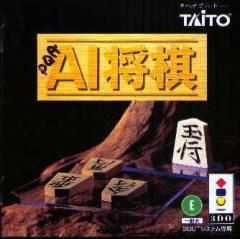Download RomStation
Install and manage your games directly from the RomStation application.
AI Shogi

Genre : Board game
Multiplayer : 2 players
Year : 1995
Developer : Taito Corporation
Publisher : Taito Corporation
By
BigBoss95
:
Shogi, also known as Japanese chess or the Game of Generals, is a two-player strategy board game native to Japan in the same family as chess, makruk, shatranj, janggi and xiangqi, and is the most popular chess variant in Japan. Shōgi means general's board game.
Shogi was the earliest chess variant to allow captured pieces to be returned to the board by the capturing player. This drop rule is speculated to have been invented in the 15th century and possibly connected to the practice of 15th century mercenaries switching loyalties when captured instead of being killed.
The earliest predecessor of the game, chaturanga, originated in India in the 6th century. Shogi in its present form was played as early as the 16th century, while a direct ancestor without the drop rule was recorded from 1210 in a historical document Nichūreki, which is an edited copy of Shōchūreki and Kaichūreki from the late Heian period (c. 1120).
Two players face each other across a board composed of rectangles in a grid of 9 ranks (rows) by 9 files (columns). In Japanese they are called Sente (first player) and Gote (second player), but in English are conventionally referred to as Black and White, with Black the first player. The board is nearly always rectangular, and the rectangles are undifferentiated by marking or color. Pairs of dots mark the players' promotion zones.
Each player has a set of 20 wedge-shaped pieces of slightly different sizes. Except for the kings, opposing pieces are undifferentiated by marking or color. Pieces face forward (toward the opponent's side); this shows who controls the piece during play.
Shogi was the earliest chess variant to allow captured pieces to be returned to the board by the capturing player. This drop rule is speculated to have been invented in the 15th century and possibly connected to the practice of 15th century mercenaries switching loyalties when captured instead of being killed.
The earliest predecessor of the game, chaturanga, originated in India in the 6th century. Shogi in its present form was played as early as the 16th century, while a direct ancestor without the drop rule was recorded from 1210 in a historical document Nichūreki, which is an edited copy of Shōchūreki and Kaichūreki from the late Heian period (c. 1120).
Two players face each other across a board composed of rectangles in a grid of 9 ranks (rows) by 9 files (columns). In Japanese they are called Sente (first player) and Gote (second player), but in English are conventionally referred to as Black and White, with Black the first player. The board is nearly always rectangular, and the rectangles are undifferentiated by marking or color. Pairs of dots mark the players' promotion zones.
Each player has a set of 20 wedge-shaped pieces of slightly different sizes. Except for the kings, opposing pieces are undifferentiated by marking or color. Pieces face forward (toward the opponent's side); this shows who controls the piece during play.
Further information :
For more rules of the Shogi game, join the link below:https://en.wikipedia.org/wiki/Shogi
Alternative versions
In the same series
There are no images in this album yet









Recommended Comments
There are no comments to display.